Imagine being a Viet Cong insurgent about to assault a firebase in Vietnam’s Central Highlands. Your outfit has been lobbing mortars into the place for a while and you’re about to go in under the barrage. Fire suddenly erupts from the night sky, and you see rivers of orange tracers descending on you. The ground explodes as you dive for cover. Risking a look skyward, you see the bright pillar of flame emanating from several thousand feet up, moving in a circle around your target. It seems that a giant dragon has risen to protect the base, its fiery breath ripping through your ranks with impunity.

If you indeed thought such a thing, you wouldn’t be far off the mark. Only this dragon is man-made, as is the flame it belches. Given the call sign “Puff,” and later “Spooky,” the American troops it protected knew it as “Puff the Magic Dragon.” Such was, and still is, the awesome firepower of the AC-130 Gunship and its predecessor, the AC-47.
The Original Spooky
The transport gunship wasn’t a new idea. The US Air Force had been converting World War II-vintage Douglas C-47 Skytrains into gunships since 1964. The nature of the Vietnam War, with American and South Vietnamese firebases scattered throughout the country and no clear front lines, often made traditional fire support difficult. Fast-responding aerial support made a lot of sense, but given that operations typically took place at night, small helicopters and traditional attack planes had limited capabilities.
The answer was arming larger transport aircraft whose space and lift capacities could handle radar and early infrared imaging systems, giving them the necessary nighttime capabilities. A new tactic, taken from air racing, was also developed to maximize those planes’ effectiveness: the pylon turn. The pylon turn enabled the aircraft to orbit the target on a known radius, allowing its guns, all mounted on the port side, to zero in on the target, unleashing sustained bursts of fire. This tactic was far more effective, and destructive, than single passes from low-flying aircraft. It was also far more accurate than dropping bombs from altitude.
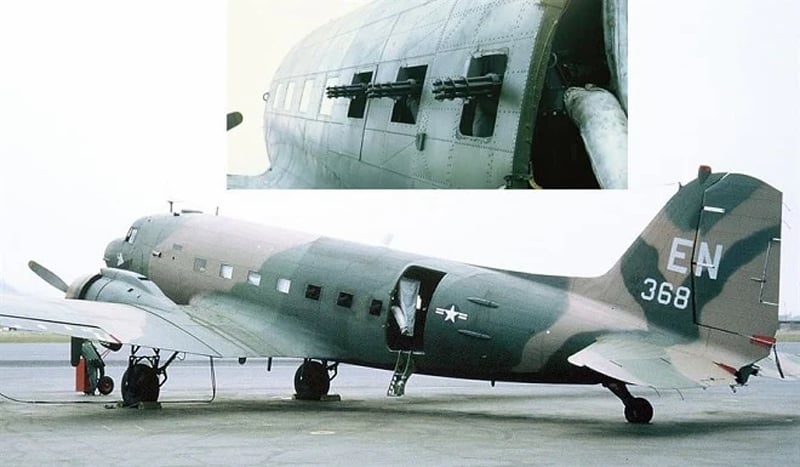
The attack transports’ altitude made them immune to small arms fire, another advantage over helicopters and attack craft, which had to hit and run before the enemy could react. Finally, the transports’ altitude and fuel payload allowed them sustained loiter times over targets, unlike smaller aircraft. All those advantages made the attack transport far more effective in the defensive ground support role. The aircraft regularly fired 20 thousand rounds, or more, on a single mission. Because they usually operated at night, the new AC-47s were dubbed “Spooky.”
No village, hamlet, or firebase protected by Spooky ever fell, including Khe Sanh, which withstood a six-month siege in 1968, though the AC-47 was only part of its defense. The AC-47’s overwhelming success led the Air Force to look for a modern upgrade to the aging aircraft.
The Upgraded Spooky
The Lockheed C-130 Hercules was the obvious choice to replace the AC-47. The C-130 offered greater lift and longer endurance than its predecessor, meaning bigger guns, more ammo, and longer time over the target. Plus, the high-mounted wings permitted a wider field of fire than the AC-47’s low-mounted wings. The first AC-130A arrived in Vietnam in September of 1967, with a full squadron deployed by October of 1968.

The AC-130’s success is well documented. It served in Vietnam, Grenada, Panama, the Gulf War, the Balkans, Iraq, Afghanistan, and probably other places for which I’m not cleared. Like the AC-47, the AC-130’s guns are mounted on the aircraft’s port side and brought to bear by using the pylon turn. The result is the destruction of whatever is on the receiving end.
The source of the AC-130’s firepower has evolved over the decades. Let’s take a look at the various guns employed by Spooky and its later variants. This article only looks at guns. The various bombs and missiles are not included for reasons of space and the fact that this is a gun blog, not a guided munitions blog.
Guns. Lots of Them.
The AC-47’s armament consisted of three 7.62mm General Electric GAU-2/M134 Miniguns and ten .30 caliber Browning M1919 machine guns. The miniguns were included on the new AC-130 gunship, while the Brownings were dropped in favor of larger, more effective weapons. Let’s start with the minigun.
General Electric 7.62mm GAU-2/A Minigun
Also designated the M134, the GAU-2/A is a six-barreled Gatling gun with an electric motor. The term “minigun” comes from its smaller size compared to the M61 Vulcan Cannon, also a Gatling design. It also refers to the GAU-2/A’s use of 7.62×51 NATO rifle rounds instead of cannon shells.
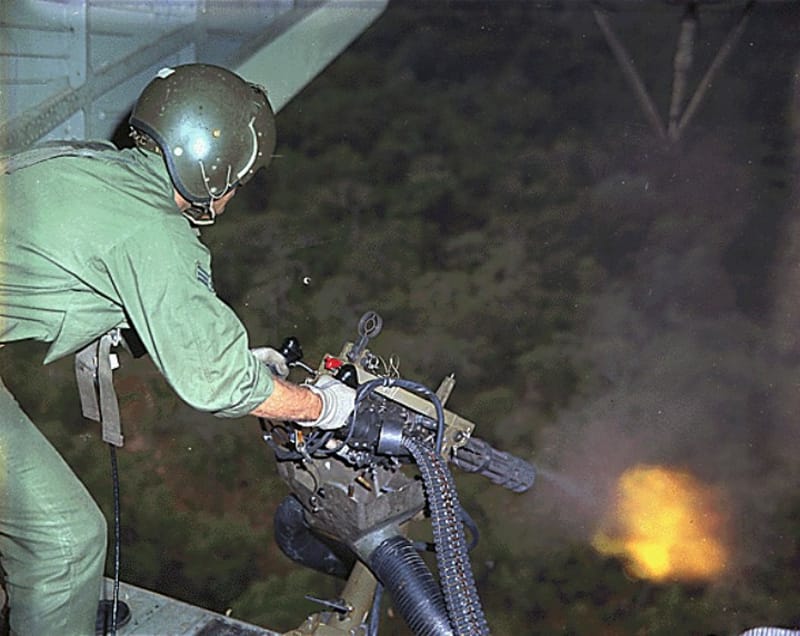
The minigun was initially used on helicopters in Vietnam. The Army went with the Gatling design because traditional single-barreled machine guns often overheated when engaging enemy forces in hot LZs. The minigun’s standard fire rate of 3,000-4,000 rounds per minute (rpm) gave helicopter door gunners the suppressive firepower they needed. Equipping the AC-47, and later the AC-130 gunships was a natural choice.
The minigun has a maximum fire rate of 6,000 rpm without overheating. The Air Force set the guns up to fire a tracer every fifth round, giving the impression that it was spitting fire, annihilating everything in its path. This was supposedly the origin of the “Puff the Magic Dragon” moniker, after a popular children’s song of the day, and likely a derivative of the original “Puff” call sign.
The GAU-2/A Minigun has a muzzle velocity of 2,800 feet per second. It equipped the AC-47, all configurations of the AC-130A (Gunship II (4), Surprise Package (2), and Pave Pronto (2)), and the AC-130E Pave Spectre (2).
M61 Vulcan 20mm Rotary Cannon
The General Electric (later General Dynamics) M61 Vulcan Rotary Cannon has been the primary cannon armament for American fixed-wing aircraft for over 60 years. The Vulcan derived from a 1946 program that built on the 20mm cannon’s success in World War II fighter planes. The dawning jet age, however, required a far greater fire rate, resulting in the Vulcan’s Gatling design. The Vulcan’s versatility makes it ideal for air-to-air and air-to-ground applications.

The Vulcan can be hydraulically, electrically, or pneumatically powered. Most aircraft versions use hydraulics, by which the rotor, barrel assembly, and ammo feed system are powered by flexible drive shafts. An electric priming system fires each round via an electric current passing through the firing pin to the primer.
The original M61 fired linked rounds, but the sheer volume of fire created major problems from spent links. The M61A1, using a linkless system, was soon introduced. The M61A1 can be equipped with a single-ended or double-ended system which either ejects the spent casings (single-ended) or returns them to the magazine (double-ended). Most aircraft-mounted Vulcans are double-ended because of foreign material hazards to jet engines.
The Vulcan’s maximum rate of fire is 6,000 rpm, though it typically carries only a minute or so worth of ammo because of weight and space restrictions. The gun is typically set for burst fire ranging from 2-3 rounds to 40-50 rounds at a time.
The Vulcan’s muzzle velocity averages 3450 feet per second. The gun equipped all configurations of the AC-130A (four on the Gunship II, two for the others), both configurations of the AC-130E (Pave Spectre (2) and Pave Aegis (2)), and the AC-130H Spectre (2).
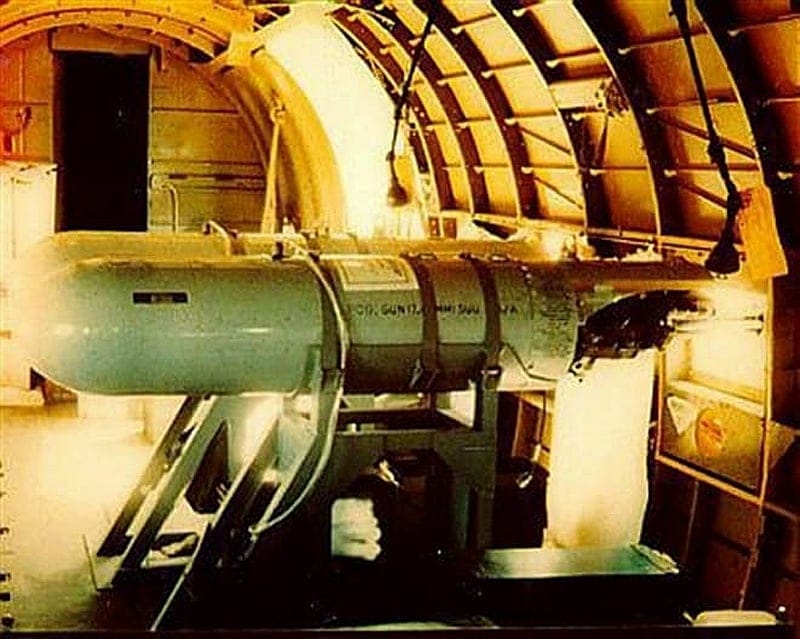
Bofors L/60 40mm Cannon
The Bofors L/60 40mm cannon was originally a Swedish design from 1934. It was used extensively as an antiaircraft gun in World War II by both sides. The Bofors fires a 2-lb. high explosive shell from a 40x311mm rimmed cartridge. The maximum fire rate for an antiaircraft gun was about 120 rpm, which could be slightly increased if the gun was horizontal, thanks to gravity assisting the feeding from the top-mounted magazine. The typical fire rate was more like 80-100 rpm.
The AC-130 Gunship used the Bofors cannon as an air-to-ground weapon. The AC-130A Surprise Package, Pave Pronto, and AC-130E Pave Spectre had twin Bofors cannons, while the AC-130H Spectre and AC130U Spooky II had one. The original AC-130A Gunship II was equipped solely with GAU-2/A Miniguns and M61 Vulcan cannons.
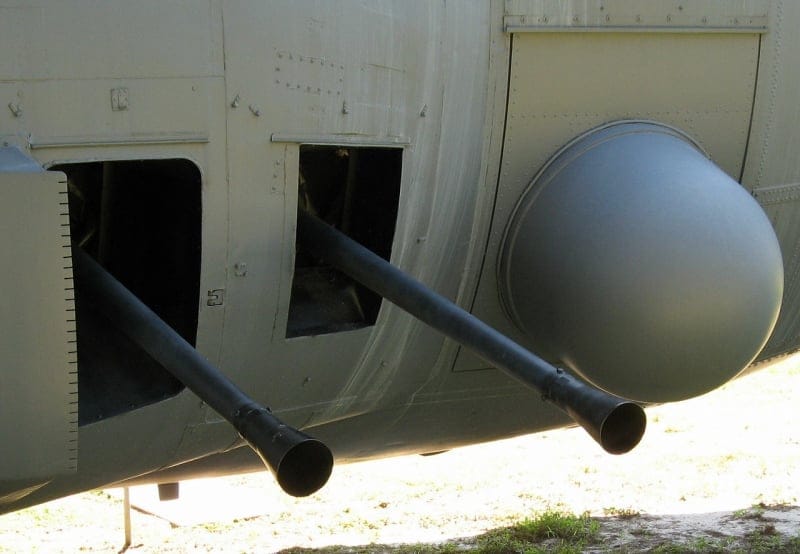
Rock Island Arsenal M102 105mm Howitzer
The M102 was the US Army’s standard light howitzer from 1966 until the early 2000s. It has since been phased out of the Regular Army but is still used by some National Guard units. Nearly a ton lighter than its predecessor, the M102 was better suited for aircraft use since the reduced weight allowed for more ammo-carrying capacity. The standard fire rate is 3 rpm. Space for the M102 was created by removing one Bofors cannon. The gun was deployed on the AC-130E Pave Aegis, AC-130H Spectre, AC-130 U Spooky II, AC-130W Stinger II, and is still used on the current AC-130J Ghostrider.
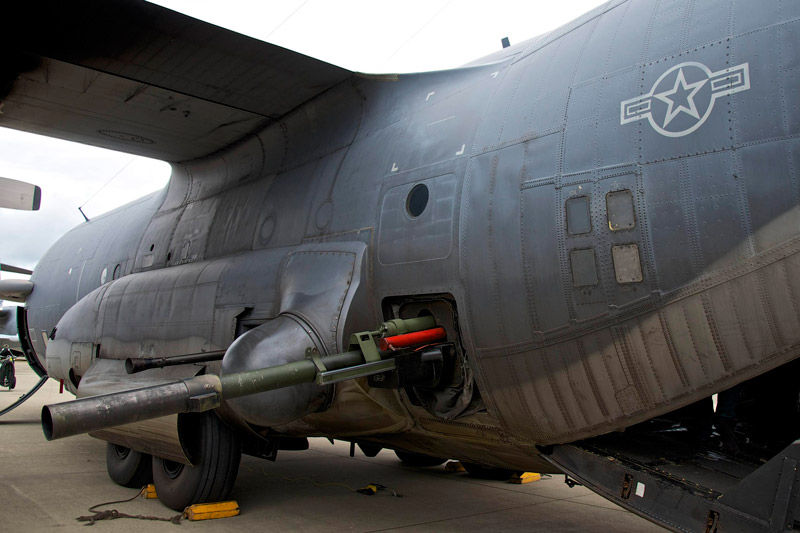
General Dynamics GAU-12/U Equalizer 25mm Rotary Cannon
The Equalizer is based on the 30mm GAU-8/A Avenger autocannon but uses updated 25mm rounds. The Gatling design allows a standard fire rate of 3,600 rpm with a maximum of 4,200 rpm. The fire rate is limited to 1,800 rpm on gunships to conserve ammo and extend barrel life. The gun is standard equipment on Harrier attack jets and is used by some ground fighting vehicles. The Equalizer’s muzzle velocity averages 3,280-3,400 feet per second. The gun was used on the AC-130U Spooky II.
ATK GAU-23/A 30mm Autocannon
The GAU-23/A replaced the Bofors 40mm cannon. It’s a 30mm chain gun made by Northrop Grumman, and fires standard GAU-8 Avenger ammo in Armor Piercing Incendiary High Explosive Incendiary, and Armor Piercing Fin Stabilizing Discarding Sabot Tracer variants. The gun was deployed on the AC-130W Stinger II and is currently on the AC-130J Ghostrider.
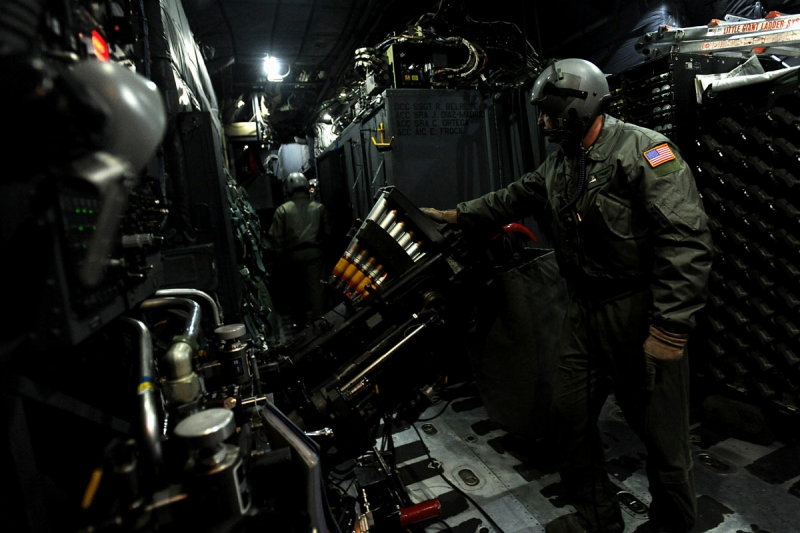
Particle Beam Laser
The Air Force recently announced plans to equip the latest AC-130s with particle beam lasers. If successful, the laser will target and destroy incoming missiles and engage ground targets such as enemy vehicles.
A Successful but Limited Platform
The AC-130 Gunship has been wildly successful since it first deployed to Vietnam in 1967. Part of that success is due to the nature of America’s wars over the last six decades. Most enemy forces have not possessed sophisticated air forces or air defense systems with which to counter the AC-130 Gunship. With a normal operating altitude of 7,000 feet and a necessarily slow airspeed, the gunships would be easy targets for a peer enemy.
This was demonstrated in Vietnam, as the Soviet Union equipped the North Vietnamese with modern antiaircraft systems. Six AC-130s fell to enemy fire between May of 1969 and December of 1972. Four gunships were shot down by antiaircraft guns, one by an SA-2 surface-to-air missile (SAM), and another by a shoulder-fired SA-7 SAM. 12 AC-47s were lost in combat.
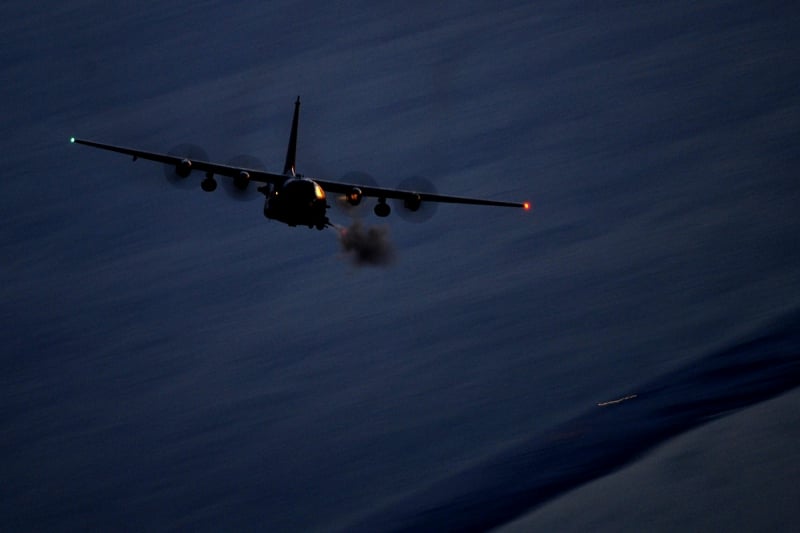
Today’s antiaircraft systems would make short work of the gunships, not to mention newer generation fighter aircraft. American forces would require, at least, air superiority and near complete ground fire suppression for the gunships to operate at all. The planned laser may or may not mitigate that situation. Of course, complete ground fire suppression would negate the need for the gunships anyway. And it’s at least questionable that such suppression could be achieved, given the proliferation of shoulder-fired SAMs.
So, the AC-130 Gunship cannot be deployed to every potential battlefield, but it will still be useful in so-called “low intensity” conflicts where modern antiaircraft measures are not present. Given the current state of the world, the gunships will likely be around for the foreseeable future, breathing fire in support of American ground troops.


